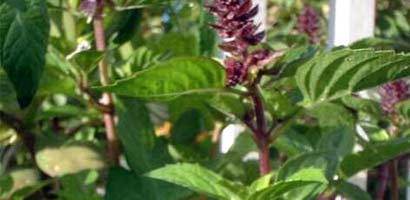
|
|||
| Ocimum santum | |||
 |
|||
| Name | |||
| Basil | |||
| Biological Name | |||
|
Ocimum basilicum, Ocimum Sanctum, Ocimum Spp. |
|||
| Other Names | |||
| Basil, Common Basil, Sweet Basil, St. Josephwort, Tulsi, Tulasi, Krishnamul, Kala Tulasi | |||
| Parts Used | |||
| Leaf, Herb | |||
| Active Compounds | |||
| Volatile oils (up to 28 percent methyl cinnamate) | |||
| History | |||
| Basil has a rich and fanciful history. It had been 'Herb royale' to the French, a sign of love to Italians, and a sacred herb in India. The first century A.D. Roman naturalist Pliny reported that basil relieves flatulence, which had been subsequently proven true. In the Far East, the herb had been used as a cough medicine, and in Africa, it has been used to expel worms. American colonists considered Basil the essential ingredient in a snuff used to ease headaches. | |||
| Remedies For | |||
|
Antispasmodic, appetizer, carminative, galactagogue, stomachic. The tea made from the leaves of the basil plant is used for nausea, gas pains, and dysentery. Tea made with basil and peppercorns is a folk remedy to reduce fever. Basil is antispasmodic, appetizer, carminative, galactagogue, and stomachic. Basil is vary useful for ailments affecting stomach and the related organs. It is used for stomach cramps, gastric catarrh, vomiting, intestinal catarrh, constipation, and enteritis. It had been sometimes used for whooping cough as an antispasmodic. Ayurvedic Applications: Action: Antibacterial, antiseptic, antispasmodic, diaphoretic, febrifuge, nervine Uses: Coughs, colds, fevers, headaches, lung problems, abdominal distention, absorption, arthritis, colon (air excess), memory, nasal congestion, nerve tissue strengthening, purifies the air; sinus congestion, clears the lungs, heart tonic; it frees ozone from sun's rays and oxygenates the body, cleanses and clears the brain and nerves; relieves depression and the effects of poisons; difficult urination, prevents the accumulation of fat in the body (especially for women after menopause), obstinate skin diseases, arthritis, rheumatism, first stages of many .cancers, builds the immune system. Tulsi contains trace mineral copper (organic form), needed to absorb iron. |
|||
| Description | |||
| An annual plant found wild in the tropical and subtropical regions of the world. The bushy stems grows to 1 to 2 feet high. The toothed leaves are often purplish hued. The flowers vary in color from white to red, sometimes with a tinge of purple, appear from June to September. The plant emits a spicy scent when bruised. This plant is an important ayurvedic herb. It is grown near Indian houses. It is believed to purify air by discharging negative ions. The plant is also believed to possess spiritual powers. For example, it opens heart and mind, gives love, devotion, faith, compassion, and clarity; cleanses the aura and it is believed to give Divine protection in the Hindu Vedas. It is one of the two most sacred plants in India. | |||
| Dosage | |||
|
Juice, infusion, powder, ghee Steep 1 tsp of dried herb in 1/2 cup water. Take 1 to 1-1/2 cups a day, mouthful at a time. Can be sweetened with honey if taken for cough. |
|||
| Safety | |||
|
US: Generally recognized as safe |
|||
|
|
|||
|
||||
| © 2004, All rights reserved. Telemedicine and Web Site Maintenance by Telemedicine India. Best Viewed in 800x600 resolution in MSIE 4.0 or above. |
